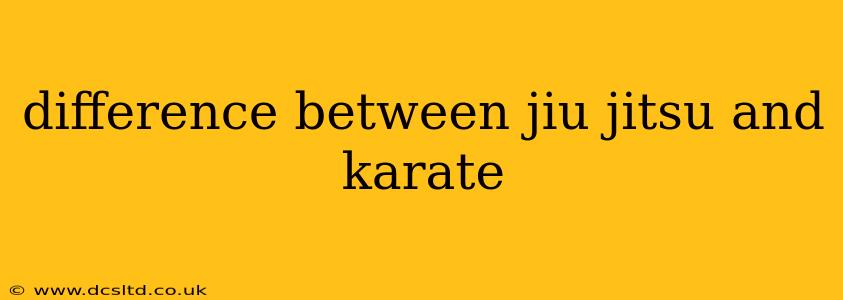Jiu-jitsu and karate are both martial arts with rich histories and distinct approaches to combat. While both involve self-defense techniques, their philosophies, training methods, and fighting styles differ significantly. This comprehensive comparison will delve into the key differences, helping you understand which might be a better fit for your interests.
What is Jiu-Jitsu?
Jiu-jitsu, particularly Brazilian Jiu-Jitsu (BJJ), focuses primarily on grappling and ground fighting. It emphasizes using leverage, technique, and strategy to subdue an opponent, often through submissions like joint locks and chokes. Strikes are generally not a primary focus in BJJ, although some variations incorporate them. The goal is to control your opponent's body and force a tap-out or submission.
What is Karate?
Karate, originating in Okinawa, is a striking-based martial art. It involves punches, kicks, blocks, and other striking techniques to disable or incapacitate an opponent from a distance or close range. While some karate styles incorporate grappling, the core emphasis remains on striking. Different karate styles exist (e.g., Shotokan, Goju-ryu, Kyokushin), each with slight variations in techniques and emphasis.
Key Differences Between Jiu-Jitsu and Karate:
Here's a breakdown of the crucial distinctions between these two martial arts:
1. Primary Focus:
- Jiu-Jitsu: Ground fighting, grappling, submissions (joint locks, chokes).
- Karate: Striking (punches, kicks, blocks).
2. Fighting Distance:
- Jiu-Jitsu: Close-range combat, often on the ground.
- Karate: Various ranges, from long-range striking to close-range clinches in some styles.
3. Training Methods:
- Jiu-Jitsu: Extensive sparring, rolling (controlled grappling), and drilling of specific techniques.
- Karate: Kata (forms), kumite (sparring), and kihon (basic techniques). Sparring can vary significantly in intensity and rules across different styles.
4. Self-Defense Applications:
- Jiu-Jitsu: Effective in close-quarters combat situations, particularly when grappling on the ground. Excellent for neutralizing a stronger opponent.
- Karate: Ideal for self-defense at a distance, effectively dealing with multiple attackers or those attempting to close the gap.
5. Physical Fitness:
- Jiu-Jitsu: Develops strength, endurance, flexibility, and cardiovascular fitness. Focuses on muscular endurance and grip strength.
- Karate: Builds strength, speed, agility, flexibility, and cardiovascular fitness. Emphasizes power and precision in strikes.
6. Competitive Aspects:
- Jiu-Jitsu: Highly competitive with various organizations and tournaments worldwide.
- Karate: Also has competitive aspects, but the rules and styles vary depending on the organization and specific karate style.
7. What style suits me best?
The best martial art for you depends on your personal goals and preferences. Consider what aspects of self-defense or physical fitness are most important to you. If you prefer close-quarters combat and grappling, Jiu-Jitsu might be a better choice. If you prefer striking and maintaining distance, Karate would be more suitable.
Which is better for self-defense?
Both Jiu-Jitsu and Karate offer excellent self-defense applications, but their effectiveness varies depending on the specific situation. Jiu-Jitsu excels in close-quarters combat and ground fighting, while Karate is better suited for situations involving distance and multiple attackers. Ideally, a comprehensive self-defense system would incorporate elements from both.
This detailed comparison helps clarify the core differences between Jiu-Jitsu and Karate. The choice ultimately rests on individual preferences and priorities. Both martial arts offer valuable skills, physical fitness benefits, and personal growth opportunities.
